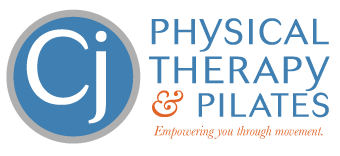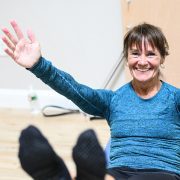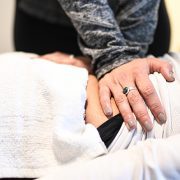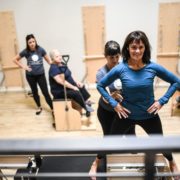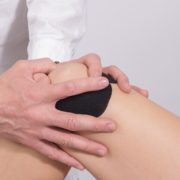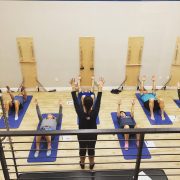At one point or another, or perhaps even this very second, you’ve experienced tight knots in your muscles.
They are annoying, nagging, uncomfortable, and quite often painful.
The most common area to feel these knots is in your upper traps (the triangle shaped area between your shoulder blades and base of your neck). But other areas of your body that love to get knotted up include your mid and lower back, your hips and butt, the front and sides of your thighs, and the back of your lower legs.
The first thing people think to do when experiencing these tight knots or muscle spasms is to get a massage or try rolling them out with a foam roller. Lately, theraguns seem to be the craze. These devices look like power drills and use percussive therapy to reduce pain and relieve tightness in the affected area. In our office, for really stubborn and painful knots, we use something called dry needling, which is where you take a tiny acupuncture needle and insert it into the tight knot to bring blood flow to the area and release tension.
These are all great options, and for the most part, I put them in the category of “Do’s” when it comes to getting rid of tight knots in your muscles.
Sounds pretty simple, right? Well, not so fast. Not all muscle knots are meant to be released.
Spil for 10 Kr.: Casizoid’s Bedste Danske Casinoer i 2025
I en verden, hvor online casinoer blomstrer som aldrig før, kan det være en udfordring at finde de bedste og mest pålidelige udbydere. Men frygter ikke, for vi har gjort det hårde arbejde for dig. I denne artikel vil vi dykke ned i de førende danske casinoer i 2025 og afsløre, hvad der gør dem så unikke og attraktive for spilleglade entusiaster som dig.
Uanset om du er en erfaren gambler eller en nybegynder på jagt efter spænding, vil vores dybdegående analyse give dig et solidt fundament for at træffe de bedste valg. Vi vil dissekere alt fra spilleudvalg og bonusser til brugeroplevelse og sikkerhed, så du kan maksimere dine chancer for succes og undgå faldgruber. Vær parat til at blive overrasket, for de casinoer, vi har udvalgt, vil ikke kun underholde dig, men også sikre, at du får mest muligt ud af dine penge.
Sikkerhed og regulering af danske casinoer
I 2025 vil de bedste danske casinoer være dem, der tilbyder en uovertruffen spilleoplevelse med en bred vifte af spændende spil og generøse bonusser. Casizoid, en af de førende anmeldelsessider for online casinoer, har udpeget de mest lovende casinoer, der vil dominere markedet i de kommende år. Disse casinoer vil sætte nye standarder for brugeroplevelse, sikkerhed og ansvarligt spil.
Et af de fremtrædende casinoer på listen er CasinoXYZ, der allerede har vundet talrige priser for sin innovative tilgang til online gambling. Med en imponerende samling af over 2.000 spil, herunder de nyeste slotmaskiner, bordspil og live-dealer-spil, lover CasinoXYZ at give spillerne en uforglemmelig oplevelse. Derudover tilbyder de attraktive velkomstbonusser og loyalitetsprogrammer, der belønner dedikerede spillere.
Et andet casino, der har tiltrukket sig opmærksomhed, er VegasCasino. Dette casino er kendt for sin brugervenlighed og sin imponerende mobilkompatibilitet. Uanset om du spiller på din smartphone, tablet eller computer, vil VegasCasino give dig en flydende og underholdende oplevelse. Deres udvalg af spil er konstant opdateret med de seneste udgivelser fra de bedste softwareudviklere i branchen.
Endelig må man ikke glemme NordicCasino, der har specialiseret sig i at tilbyde en autentisk og sikker spilleoplevelse til nordiske spillere. Med en kundeservice, der taler flydende dansk, og betalingsmetoder, der er tilpasset det nordiske marked, har NordicCasino vundet tilliden hos mange lokale spillere. Deres spilbibliotek indeholder klassiske favoritspil såvel som innovative nye titler, der sikrer, at der er noget for enhver smag.
Populære spil og jackpotter
I 2025 vil online casinoer i Danmark have taget et enormt spring fremad i forhold til i dag. Spil for 10 Kr.: Casizoid’s Bedste Danske Casinoer i 2025 vil byde på en helt ny oplevelse med utroligt realistiske og immersive spil. Takket være den hastige teknologiske udvikling vil grafikken være så levende, at man næsten kan føle sig som om man sidder ved et rigtigt casinobord. Desuden vil udvalget af spil være enormt, og der vil være noget for enhver smag, uanset om man foretrækker klassiske casinospil eller de nyeste og mest innovative titler.
Et af de vigtigste aspekter ved casinoer med 10 kr. i 2025 vil være den forbedrede brugervenlighed. Hjemmesiderne vil være intuitive og nemme at navigere, og der vil være masser af nyttige funktioner som live chat-support og detaljerede vejledninger til spillene. Derudover vil sikkerheden være i top, og man kan føle sig tryg ved at spille på disse casinoer. Alt i alt lover Casizoid’s Bedste Danske Casinoer i 2025 at være en sand oplevelse for alle casinoentusiaster.
Mobilvenlige casinoer og apps
I 2025 vil online casinoer i Danmark være mere spændende end nogensinde før. Casizoid, den førende autoritet inden for anmeldelser af online casinoer, har allerede udpeget de bedste danske casinoer for det kommende år. Disse casinoer lover at tilbyde en uovertruffen spilleoplevelse med et bredt udvalg af spil, generøse bonusser og fremragende kundeservice.
Blandt de højst rangerede casinoer finder du velkendte navne som CasinoMagic, SpilenDanmark og CasinoSikker. Disse casinoer har bevist deres værdi gennem årene og fortsætter med at imponere spillere med deres innovative tilgang til online gambling. Uanset om du foretrækker klassiske casinospil som roulette og blackjack, eller du er mere til de nyeste slotmaskiner og live dealer-spil, vil du finde noget, der passer til din smag på Casizoid’s liste over de bedste danske casinoer i 2025.
Kundeservice og bonustilbud
I 2025 vil Casizoid’s liste over de bedste danske casinoer være fyldt med spændende og innovative tilbud. Online casinobranchen udvikler sig konstant, og spillerne kan forvente endnu flere underholdende og belønningsrige oplevelser. De førende casinoer vil tilbyde en bred vifte af spil fra anerkendte udviklere, herunder de seneste slotmaskiner, bordspil og live casino-titler.
Sikkerheden og integriteten vil fortsat være en topprioritet for Casizoid’s anbefalede casinoer. Spillerne kan forvente robuste sikkerhedsforanstaltninger, herunder kryptering på højt niveau, ansvarlig spilpolitik og retfærdig spilafvikling. Desuden vil de bedste casinoer tilbyde hurtige og pålidelige indbetalings- og udbetalingsmetoder, så spillerne kan nyde en smidig og problemfri oplevelse.
Endelig vil mobil- og VR-teknologien spille en større rolle i 2025. De bedste danske casinoer vil tilbyde fuldt optimerede mobilversioner af deres platforme, så spillerne kan nyde deres yndlingsspil hvor som helst og når som helst. Derudover kan vi forvente at se flere casinoer, der implementerer virtual reality-teknologi, hvilket vil give spillerne en endnu mere immersiv og realistisk oplevelse.
Uanset om du er en erfaren spiller eller helt ny i casino-verdenen, er det vigtigt at vælge et sikkert og pålidelig online casino. Med de mange muligheder, der er tilgængelige, kan det være en udfordring at finde det rette sted at spille. Men med vores grundige research og anbefalinger, kan du være sikker på, at du får den bedste oplevelse, når du spiller for 10 kr. på Casizoid’s bedste danske casinoer i 2025. Vores eksperter holder konstant øje med markedet og opdaterer vores liste, så du altid har adgang til de nyeste og mest spændende casinoer, der tilbyder fantastiske spil, generøse bonusser og en sikker og tryg spilleplatform.
“Don’t” aggressively release a tight knot in your muscle until you know why it’s there.
Sometimes, muscle knots form as a critical compensatory strategy. If released too quickly, they can set off an array of problems. I was just talking to my massage therapist about this, because she’s seen it happen to her own clients. Occasionally, she’ll work her magic to get rid of tight muscle knots only to find the client feels worse after the session. This can happen when the tight knot was there to compensate for a weak muscle elsewhere.
Let me explain.
Muscles are connected via highly innervated tissue called fascia. It looks like a spider web and one of its main functions is to connect organs and muscles together. Fascia is still being studied, but one of the theories is that if one muscle group in that fascial line is not doing its job, a different muscle will work extra hard in its place to take up the slack. Eventually, that muscle will get exhausted and tighten up into a knot, because it’s doing more work than it was designed to.
If you release a knot that is “holding the line” together, you’re asking for trouble.
In this example, what I’ve found is that the passive methods of releasing muscles (those I mentioned earlier) aren’t very effective at helping you get rid of the problem. You might actually end up feeling worse or having pain elsewhere. If your tight muscle knot is there to act as a survival mechanism, it’s going to take a more comprehensive and total body approach to resolve it. You’ll need to figure out which muscle or muscles the tight knot is compensating for and address them at the same time you work to release the tight knot. You can keep getting your weekly massage, but you’ve got to pair it up with correctly prescribed exercises.
To summarize, DO figure out WHY you have a tight knot in your muscle first.
Is it there because you overworked it in the gym? Maybe you’ve taken on a new project at home that is repetitive in nature?
If these are the reasons you’ve got tight knots in your muscles, then DO release them. You’ll likely feel better. And then correct the movement patterns, so the knot doesn’t come back.
If you feel worse after releasing the tight knots in your muscles, or the knot keeps coming back, then the problem likely involves more than just that muscle and you need a more comprehensive approach to get rid of it.
DON’T continue to release it over and over.
If you’re suffering from stubborn knots that won’t go away, get assessed by movement experts like us who can diagnose your problem accurately and help you get rid of the tight knots in your muscles for good.
Dr. Carrie Jose – back pain specialist and Pilates expert – owns CJ Physical Therapy & Pilates in Portsmouth, NH
